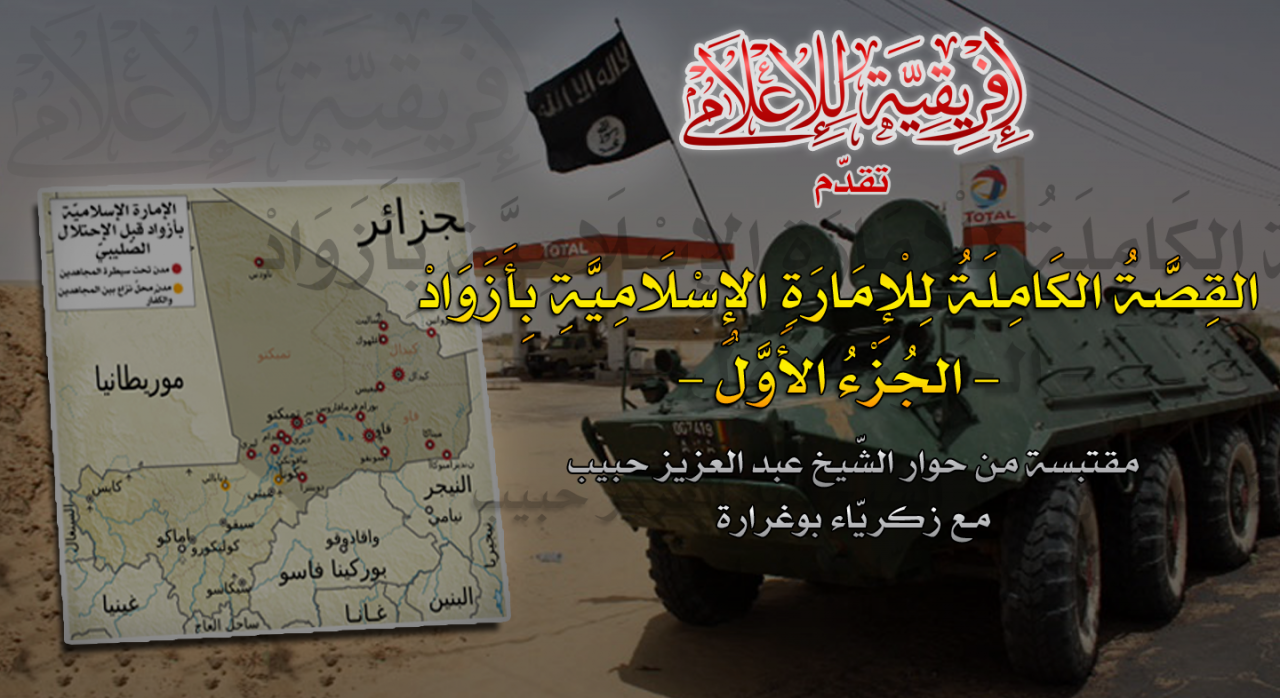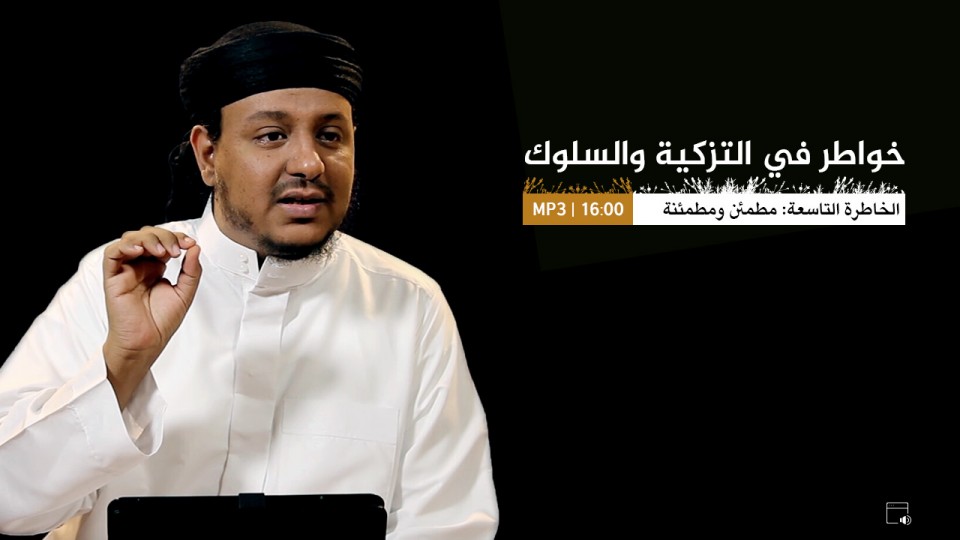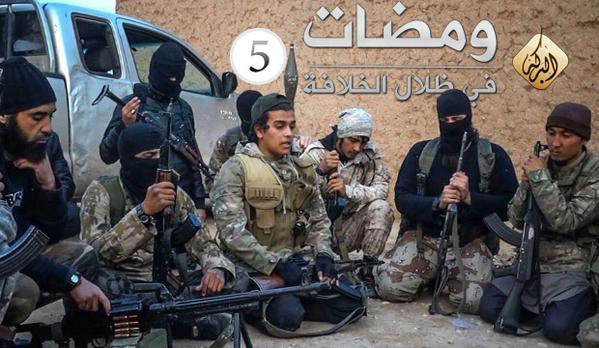
_______________
To inquire about a translation for this video message for a fee email: [email protected]
Day: January 16, 2015
New video message from The Islamic State: "Medical Services in the City of Jarābulus – Wilāyat Ḥalab"

_______________
To inquire about a translation for this video message for a fee email: [email protected]
New video message from The Islamic State: "Interviews About the Jordanian Pilot – Wilāyat al-Raqqah"

______________
To inquire about a translation for this video message for a fee email: [email protected]
New video message from The Islamic State: "Words Narrated In Blood #2 – Wilāyat al-Khayr"
NOTE: Click here for the first part in the video series.
—

______________
To inquire about a translation for this video message for a fee email: [email protected]
Ifrīqīyyah Media presents excerpts from the dialogue of Shaykh 'Abd al 'Azīz Ḥabīb with Zakarīā' Būghrārah: "The Full Story of the Islamic Emirate of Azawad, Part 1"

Click the following link for a safe PDF copy: Zakarīā’ Būghrārah — “The Full Story of the Islamic Emirate of Azawad, Part 1”
______________
To inquire about a translation for this statement for a fee email: [email protected]
Ifrīqīyyah Media presents a new video from Katībat ‘Uqbah Ibn Nāfi': "From the Mountains of Ifrīqīyyah: Message From the Martyr Musā al-Tūnisī and Documenting the Path"

_______________
To inquire about a translation for this video message for a fee email: [email protected]
The Clear Banner: French Foreign Fighters in Iraq 2003-2008
The Clear Banner sub-blog on Jihadology.net is primarily focused on Sunni foreign fighting. It does not have to just be related to the phenomenon in Syria. It can also cover any location that contains Sunni foreign fighters. If you are interested in writing on this subject please email me at azelin [at] jihadology [dot] net.
—
French Foreign Fighters in Iraq 2003 – 2008
By Timothy Holman
Initial assessments by French and US intelligence from 2005, cited in press in 2008, evaluated that there was a significant risk of attacks by eventual returnees from the Iraq theatre. These assessments were drawn-up amongst early reports of hundreds of foreign fighters from Europe.i By 2008, the numbers of European foreign fighters had not reached the initially anticipated volumes and attacks had not materialized.ii In fact, French foreign fighters were now seeking to enter Afghanistan, having abandoned the idea of foreign fighting in Iraq as either too dangerous or as no longer being a ‘pristine jihad’.iii
The attention of French and other Western authorities turned to al-Qaeda core (AQC) members in the Af/Pak zone who remained active in planning and supporting attacks against the West, and later towards Yemen, where a rejuvenated al-Qaeda in the Arabian Peninsula (AQAP), demonstrated deadly intent and resourcefulness in targeting the United States.iv The Iraq-era networks and their apparently diminishing threat slowly receded into the background as these AQ-affiliated entities focused their attention on attacking the West. The beginning of the conflict in Syria and the flood of European foreign fighters meant the Iraq-era networks were for the most part not a subject of study or analysis.v
The Paris and Toulouse attacks in France were perpetrated by foreign fighters with associations to jihadist networks that first came to the attention of the French authorities in the wake of the United States invasion of Iraq and a renewed surge in interest in foreign fighting. The French and Belgian authorities disrupted these networks in early 2005 (Buttes-Chaumont, Paris) and early 2007 (Artigat, Toulouse region and Brussels, Belgium). Despite the action and activities (arrests, trials and imprisonment) by the French authorities, members of the networks continued to associate, radicalize, and form new relationships, in the context of these evolving networks. In the cases of some, their intent moved from foreign fighting abroad, to attacking inside France.
The French Iraq-era Networks and Clusters
In September 2004, the French authorities opened a judicial investigation into what they termed the ‘filières irakiennes’ (Iraq networks). Six cases were brought to trial; the 19th network/ Buttes-Chaumont group, the Montpellier cluster, the Nice cluster, the Ansar al-Fath group, the Tours cluster, and the Artigat network.vi The 19th network sent the most individuals into Iraq. The Montpellier cluster sent two persons to Syria; one travelled to Iraq, the second desisted and returned to France where he was arrested. The Nice cluster network was an investigation into connections to individuals in the Kari network in Belgium, which also resulted in a trial and convictions. The Ansar al-Fath group was formed around a former Groupe Islamique Armé (GIA) member and individuals he had met in prison. The group initially had the intention of engaging in foreign fighter activity but was redirected into domestic plotting through the instructions of a Syria-based Tunisian facilitator. The group then concentrated its energy into this activity; overseas travel was to Lebanon for training in explosives. The French authorities disrupted the group and the individuals imprisoned.vii In October 2006, three residents of Tours, France traveled to Damascus, Syria with the intention of crossing into Iraq to fight against United States (US) military forces. The three men were rapidly arrested by Syrian security forces as they sought to locate a smuggler to take them across border. They were eventually deported to France and tried.viii This cluster mostly closely resembles the types of individuals that would later participate in the Syria mobilization from France.ix
The Artigat network was a Toulouse-based entity, whose members congregated around a Syrian Afghanistan-veteran in the small town of Artigat. Others traveled to Cairo, Damascus, and in the case of one to Medina, in Saudi Arabia. The travel was for a combination of Arab-language training and to be able to live in countries perceived as better adapted to their faith.x Over-time some members became interested in foreign fighting. Attempts were made to enter Iraq using a Saudi Arabia-based facilitator, who had come into contact with the student based in Medina. The existence and activities of the group became well known to the general public following the 2012 attacks in southwest France by Mohamed Merah. Merah was friends with a core member of the group, and Merah’s brother and sister were also actively engaged in the network. The network continued to exist in some form even after the Toulouse attacks, and members associated with the network have traveled to Syria, including Merah’s sister.xi Since the network formed, participants have been involved in a combination of ‘hijra’, foreign fighting, and domestic terrorist activity.
The story of the 19th network is now well known following the Paris attacks.xii It has origins in Farid Benyettou’s contacts with individuals engaged in militant activity and el-Hakim’s travel to Syria and Iraq and relationships formed while living there. A group of comprised of friends and family members grew around Benyettou in their neighborhood in Paris. Incensed by the war in Iraq and images of Abu Ghraib, the network mobilized to send themselves to fight in Iraq. The group was eventually disrupted from 2004 onwards by a combination of arrests by the US, Syrians and French. A 2008 trial saw members sentenced with some released due to time-served while others returned to prison to see out the remainder of their sentences. In 2010, a small cluster of members through contacts made in prison sought to organize to free an imprisoned GIA bomb maker responsible for the 1995 metro bombings.xiii The planning was organized by a former Afghanistan networks facilitator, Djamel Behgal, who had been assigned to residence following the end of his prison term, while awaiting the result of court proceedings to expel him from France to Algeria. Some members of this group were tried and sentenced in 2013, while others were released due to lack of evidence. A third and final cluster formed between the remnants of the 19th network, and the Beghal cluster. This small cluster would go on to plan and execute the most lethal attacks in France since 1961.xiv
What happened to the French foreign fighters?
Thomas Hegghammer estimates that about 100 European foreign fighters travelled to Iraq.xv My preliminary research has found traces of approximately 54 names of foreign fighters from Europe, who traveled or tried to travel to Iraq from 2003 onwards. They originate from ten countries, nine in Western Europe and one in the Western Balkans. It is probable that there were more fighters, but to-date searches in press reports, judicial documents, martyrs lists, captured terrorist documentation and estimates of captured foreign fighters by the US military give a figure of 54 foreign fighters originating from Europe. This figure is a long way from the estimated 3000 Western Europeans who have traveled to Syria and more recently again to Iraq.xvi
A Preliminary Estimate of European Foreign Fighters in Iraq (2003-2008) and Syria (2011 onwards)
The Iraq numbers are calculated from known travelers to Iraq. The list includes some who were arrested in Syria while attempting to enter Iraq and others who reached Syria but returned home unable to find a facilitator. The Syria numbers come from press reporting or statements by governments compiled in late 2014. See blog post, “Black Math: Getting more from the Foreign Fighter Numbers”, October 10, 2014, https://acrossthegreenmountain.wordpress.com/2014/10/10/black-math-getting-more-from-the-foreign-fighter-numbers/. The French numbers exclude those wanting to travel and those in transit.
Despite the low absolute numbers, but similar to Syria, French foreign fighters formed the largest proportion – 39% – of the European contingent. According to my research there were 21 persons who traveled at least as far as Syria. Marc Trévidic estimates that there were 30 French foreign fighters but publicly available information currently exists for 21.xvii The French foreign fighters came in their majority from the Buttes-Chaumont network. The numbers used in the analysis that follows draw on the figure of 21, as there is some data on what happened to these fighters. The small sample size means that the observations from the analysis are tentative and subject to revision as more information becomes available.xviii
What Happened to the French Foreign Fighters in Iraq
|
Status |
Number |
Notes |
| Arrested in Syria |
5 |
Two from the Artigat network and three from Tours cluster. |
| Dead |
5 |
Four from 19th, and one from Montpellier |
| Imprisoned in Iraq |
1 |
One from 19th (excludes second 19th member who escaped prison and returned to France, counted as a returnee) |
| Returnee |
4 |
Three from 19th and one from Montpellier |
| Unknown |
2 |
Individual who traveled possibly from Marseilles with Italy-based Tunisians, individual mentioned in Sinjar documents. |
| Unknown presumed dead |
3 |
One from 19th, one from Nice cluster and one from Artigat network. |
| Unsuccessful |
1 |
Associate of 19th who traveled later to Syria circa. 2007 |
| Total |
21 |
|
The majority of the French foreign fighters traveled in two waves to try and enter Iraq, 41% (9 fighters) in 2004 and 30% (6 fighters) in 2006. The largest number of successful entries was in 2004, when all of the foreign fighters were able to enter Iraq compared to 2006, when only one of the six travelers is reported to have successfully crossed from Syria into Iraq.
The data indicates that there were four returnees. The Montpellier grouping provided the first returnee, although, this individual’s status as returnee could be questioned, as he appears to have traveled as far as Syria and then renounced traveling further when he understood he could be tasked to carry-out a suicide bombing. The other three returnees came from the 19th network.
Three of the four returnees engaged in some form of domestic activity.
al-Malāḥim Media presents a new audio message from al-Qā’idah in the Arabian Peninsula’s Hārith bin Ghāzī al-Naẓārī [Muḥammad al-Mirshadī]: “Thoughts in Testimonial and Behavior #9: Reassuring and Comforting"
NOTE: For previous parts in this series see: #8, #7, #6, #5, #4, #3, #2, and #1.
—

Hārith bin Ghāzī al-Naẓārī [Muḥammad al-Mirshadī] — “Thoughts in Testimonial and Behavior #9- Reassuring and Comforting”
_______________
To inquire about a translation for this audio message email: [email protected]
Ajnād Foundation For Media Production presents a new Nashīd from The Islamic State: "The Land of Sinai"

The Islamic State — “The Land of Sinai”
______________
To inquire about a translation for this nashīd for a fee email: [email protected]
New video message from The Islamic State: "Glances in the Shadows of the Caliphate #5 – Wilāyat al-Barakah"
NOTE: For earlier parts in this series see: #4, #3, #2, and #1.
—

______________
To inquire about a translation for this video message for a fee email: [email protected]
